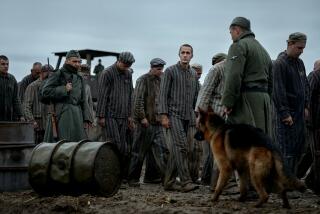Author Finds Holocaust Children Used Games to Play Out Their Fear
Stripped of their innocence at an early age, Jewish children who were held prisoner in concentration camps and relocated to ghettos during World War II spent their few idle moments playing “Gas Chamber,” “Gestapo Agent” and other games that reflected the horror of their surroundings.
Rather than play games that would help them escape their misery, these children, ages 2 to 14, often played games that mirrored their surroundings, said George Eisen, a Cal Poly Pomona physical education professor. He has written “Children and Play in the Holocaust,” published by the University of Massachusetts Press.
The book describes games played by Jewish children who lived in concentration camps, ghettos and in hiding during Germany’s occupation of Europe. The Nazis systematically exterminated 6 million Jews, an estimated 1 million of them children.
Eisen found that in Auschwitz, children played “Gas Chamber,” during which they would imitate the screams of the people they heard being gassed to death.
Pretending to be Hitler
In “Burial,” they mimicked the mass burials conducted by the Germans. A few children would lie down and play dead, and others would roll them into shallow graves. In one variation of the game, a child pretended to be a dead Adolph Hitler.
Other games included “Doctor,” in which a child would take food rations away from children pretending to be sick and refuse to help them without a bribe, and “Blockade,” in which the children reenacted being sealed off from their families by German forces.
The children also played “Blowing Up Bunkers,” “Slaughter,” and “Seizing the Clothes of the Dead.”
“Games in any culture are an important means to understanding reality,” said Eisen, a Jewish native of Hungary whose field of study concerns the sociology of sports.
“Playacting came to provide a naturally reflective mirror of all the sorrows, dismay and absurdity of the children’s brief existence,” Eisen says in the book.
“This transcends the Holocaust,” he said. “Mass exterminations have occurred in Beirut, Lebanon, Cambodia and Ireland. Where playing reflects the surroundings, where children have been traumatized, it means they will be traumatized in adult life as well.”
Imitating What They Saw
Eisen, who as a youth spent a year in hiding with his Jewish mother while his father was held prisoner in a concentration camp, said the children didn’t necessarily play to have fun. Rather, they may have been imitating what they saw in an attempt to understand and cope with the atrocities surrounding them.
As their living conditions worsened and the children saw the murder of hundreds of their friends, relatives and acquaintances, the games increasingly became anti-German.
“Quite often it was hard to recruit a group of children willing to play the hated enemy, the German soldiers,” writes Eisen.
The repercussions of these games followed the children into adulthood, Eisen said. “They didn’t necessarily go back to playing regular games after the war, and many had recurring nightmares and major emotional problems,” he said.
An anonymous source in the book says that because of her experiences in two concentration camps, “I don’t even feel I know how to play and I found that it’s a very big lack with my own children.”
Eisen said that although adults in the ghettos participated in games such as volleyball and track, they played for a different reason.
“The major difference between adults and children was that adults used games for escapist reasons,” he said. “Adults have the power to rationalize their actions; children don’t.”
Eisen was born in German-occupied Hungary in 1943. He has taught in Cal Poly Pomona’s physical education department since 1979. He attended high school in Hungary, college in Israel and received a doctorate from the University of Maryland. While in Israel, he enlisted in the Jewish army.
He got the idea for this book while researching organized Jewish sports in pre-World War 11 Europe for his doctorate degree.
While working on his dissertation in 1979 on the social and political aspects of sports in Europe, Eisen came upon the diary of a Jewish ghetto resident. It questioned how the Jews could play games while they were being systematically exterminated.
He mentally filed the topic away, and later spent three years traveling to Israel and Europe, visiting concentration camps and looking through archival documents.
Eisen said he was fascinated by the “coexistence of games and sport and mass murder, the ability of the the Jews to maintain life amidst death.”


